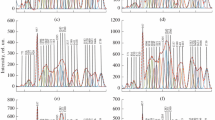Summary
Crystallinity of mineral in human pineal calcospherulites was determined by electron spin resonance spectrometry after irradiation of the samples with gamma rays in a60Co-source. The radiation-induced stable paramagnetic centers in the crystalline lattice of hydroxyapatite crystals were used as a marker of the crystalline fraction and related to the total mineral content. The crystallinity of pineal sand is higher than that of compact bone. The numerical value of the crystallinity coefficient depends on both the average crystal size of hydroxyapatite and the percentage of the crystalline fraction in the total amount of mineral. Literature data show that the average size of hydroxyapatite crystals in pineal sand are smaller than in bone tissue. It is, therefore, concluded that the higher crystallinity of pineal acervuli is due to the lower percentage of the submicrocrystalline fraction in their mineral.
Similar content being viewed by others
References
Krstić, R.: A combined scanning and transmission electron microscopic study of electron probe microanalysis of human pineal acervuli, Cell Tissue Res.174:129–137, 1976
Angervall, L., Berger, S., Röckert, H.: A microradiographic and X-ray crystallographic study of calcium in the pineal body and in intracranial tumors, Acta Pathol. Microbiol. Scand.44:113–119, 1958
Earle, K.M.: X-ray diffraction and other studies of the calcareous deposits in human pineal glands, J. Neuropathol. Exp. Neurol.24:108–117, 1965
Mabie, C.P., Wallace, B.M.: Optical, physical and chemical properties of pineal gland calcifications, Calcif. Tissue Res.16:59–71, 1974
Krstić, R., Golaz, J.: Ultrastructural and X-ray microprobe comparison of gerbil and human pineal acervuli, Experientia33:507–508, 1977
Cohen, M., Lippman, M., Chabner, B.: Role of pineal gland in aetiology and treatment of breast cancer, Lancet2:814–816, 1978
Cohen, M., Roselle, D., Chabner, B., Schmidt, T., Lippman, M.: Evidence for a cytoplasmic melatonin receptor, Nature274:894–895, 1978
Posner, A.S.: Crystal chemistry of bone mineral, Physiol. Rev.49:760–792, 1969
Posner, A., Betts, F.: Synthetic amorphous calcium phosphate and its relation to bone mineral structure, Accounts Chem. Res.8:273–281, 1975
Quinaux, N.: Doctoral Thesis, University of Liége, Liége, 1968
Houben, J.L.: Free radicals produced by ionizing radiation in bone and its constituents, Int. J. Radiat. Biol.20:373–389, 1971
Ostrowski, K., Dziedzic-Goclawska, A., Stachowicz, W., Michalik, J.: Sensitivity of the electron spin resonance technique as applied in histochemical research on normal and pathological calcified tissues, Histochemie32:343–351, 1972
Ostrowski, K., Dziedzic-Goclawska, A., Stachowicz, W., Michalik, J.: Accuracy, sensitivity and specificity of electron spin resonance analysis of mineral constituents of irradiated tissues, Ann. N.Y. Acad. Sci.238:186–201, 1974
Ostrowski, K., Dziedzic-Goclawska, A.: Electron spin resonance spectrometry in investigations on mineralized tissues. In G.H. Bourne (ed.): The Biochemistry and Physiology of Bone, 2nd edition, vol. 4, pp. 303–327, Academic Press, New York, 1976
Ostrowski, K., Dziedzic-Goclawska, A., Stachowicz, W.: Stable radiation induced paramagnetic entities in tissue mineral. In W.A. Pryor (ed.): Free Radicals in Biology, vol. 4 (in press). Academic Press, New York, 1980
Michalik, J.: Electron spin resonance studies of gamma irradiated biological and synthetic hydroxyapatites (in Polish). Doctoral Thesis, Institute of Nuclear Research, Warsaw, 1975
Jackson, S.A., Cartwright, A.G., Lewis, D.: The morphology of bone mineral crystals, Calcif. Tissue Res.25:217–222, 1978
Armstrong, M.D., Singer, L.: Composition and constitution of the mineral phase of bone, Clin. Orthop. Rel. Res.38:178–190, 1967
Dallemagne, M.J., Richelle, L.J.: Inorganic chemistry of bone, In I. Zipkin (ed.): Biological Mineralization, pp. 23–42. John Wiley & Sons, New York, 1973
Frank, R.M.: Electron microscopy of the dental hard tissues. In I. Zipkin (ed.): Biological Mineralization, pp. 413–432. John Wiley & Sons, New York, 1973
Serway, R.A., Marshall, S.A.: Electron spin resonance absorption spectra of CO3 −1 and CO3 −3 molecule ions in irradiated single crystal calcite, J. Chem. Physics46:1949–1952, 1967
Glinskaya, L.G., Shteherbakova, M.J., Zanin, J.N.: Carbon in apatite structure as studied by esr technique, Crystallographia15:1164–1167, 1970 (in Russian)
Author information
Authors and Affiliations
Rights and permissions
About this article
Cite this article
Ostrowski, K., Dziedzic-Goclawska, A., Michalik, J. et al. Crystallinity of human pineal calcospherulites. Calcif Tissue Int 30, 179–182 (1980). https://doi.org/10.1007/BF02408625
Received:
Revised:
Accepted:
Issue Date:
DOI: https://doi.org/10.1007/BF02408625




